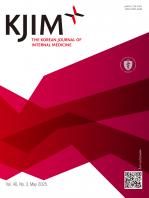|
Nephrology / Review
Glial cell line-derived neurotrophic factor and its role in attenuating renal fibrosis: a review
Yousuf Abdulkarim Waheed, Wokuheleza Buberwa, Dong Sun
Korean J Intern Med. 2025;40(2):219-229. Published online December 13, 2023
Chronic kidney disease is estimated to affect approximately 10 to 15% of the Chinese population. Renal fibrosis is characterized by progressive extracellular matrix deposition in the kidney parenchyma with eventual tissue scarring and inevitable deterioration of renal function. Vascular rarefaction,..
|
|
|
Gastroenterology / Original Article
Improved anti-fibrotic effects by combined treatments of simvastatin and NS-398 in experimental liver fibrosis models
Seong Hee Kang, Hyung Joon Yim, Ji-won Hwang, Mi-jung Kim, Young-Sun Lee, Young Kul Jung, Hyungshin Yim, Baek-Hui Kim, Hae-Chul Park, Yeon Seok Seo, Ji Hoon Kim, Jong Eun Yeon, Soon Ho Um, Kwan Soo Byun
Korean J Intern Med. 2022;37(4):745-756. Published online June 8, 2022
Background/Aims: Efficient anti-fibrotic therapies are required for the treatment of liver cirrhosis. Hydroxymethylglutaryl-coenzyme A reductase inhibitors (statins) and cyclooxygenase-2 (COX-2) inhibitors have been reported to have anti-fibrotic effects. Here, we investigated whether combined treat..
|
|
|
Infectious diseases / Original Article
Eosinophil-mediated lung inflammation associated with elevated natural killer T cell response in COVID-19 patients
Dong-Min Kim, Jun-Won Seo, Yuri Kim, Uni Park, Na-Young Ha, Hyoree Park, Na Ra Yun, Da Young Kim, Sung Ho Yoon, Yong Sub Na, Do Sik Moon, Sung-Chul Lim, Choon-Mee Kim, Yeon-Sook Kim, Nam-Hyuk Cho
Korean J Intern Med. 2022;37(1):201-209. Published online September 27, 2021
Background/Aims: Coronavirus disease 2019 (COVID-19) is associated with acute respiratory syndrome. The mechanisms underlying the different degrees of pneumonia severity in patients with COVID-19 remain elusive. This study provides evidence that COVID-19 is associated with eosinophil-mediated inflam..
|
|
|
Gastroenterology / Original Article
Anti-fibrotic effects of branched-chain amino acids on hepatic stellate cells
Hae Lim Lee, Jungmin Lee, Jung Hoon Cha, Sungwoo Cho, Pil Soo Sung, Wonhee Hur, Seung Kew Yoon, Si Hyun Bae
Korean J Intern Med. 2022;37(1):53-62. Published online July 29, 2021
Background/Aims: Patients with liver cirrhosis (LC) have low levels of branchedchain amino acids (BCAAs). There is accumulating evidence that BCAAs have anti- fibrotic effects in cirrhosis. This study is aimed to evaluate the effect of BCAAs on the function and phenotype of activated hepatic stellate..
|
|
|
Review
Cellular immunotherapy in multiple myeloma
Manh-Cuong Vo, Thangaraj Jaya Lakshmi, Sung-Hoon Jung, Duck Cho, Hye-Seong Park, Tan-Huy Chu, Hyun-Ju Lee, Hyeoung-Joon Kim, Sang-Ki Kim, Je-Jung Lee
Korean J Intern Med. 2019;34(5):954-965. Published online February 15, 2019
In multiple myeloma (MM), the impaired function of several types of immune cells favors the tumor’s escape from immune surveillance and, therefore, its growth and survival. Tremendous improvements have been made in the treatment of MM over the past decade but cellular immunotherapy using dendritic..
|
|
|
Rheumatology / Original Article
The evaluation of cellular immune function in elderly patients with systemic lupus erythematosus
Kun Men, Yu Chen, Jingwei Zhang, Dianjun Wei
Korean J Intern Med. 2019;34(4):932-937. Published online November 29, 2017
Background/Aims: To evaluate cellular immune function in systemic lupus erythematosus (SLE) patients over 60 years old, the association between antinuclear antibody (ANA) titers and the ratio of CD4+ /CD8+ was analyzed in this study. The distribution of ANAs and extractable nu..
|
|
|
Cardiology / Review
Extracellular vesicles in renal physiology and clinical applications for renal disease
Soon Hyo Kwon
Korean J Intern Med. 2019;34(3):470-479. Published online April 30, 2019
Many cells in the nephron release extracellular vesicles (EVs). EVs envelop nucleic acids, proteins, and lipids. The surfaces of EVs express donor cell-specific markers, ligands, and major histocompatibility complex molecules. They are involved in cell-to-cell communication, immune modulation, and t..
|
|
|
Nephrology / Review
Clinical significance of Th17 cells in kidney transplantation
Byung Ha Chung, Chul Woo Yang, Mi-La Cho
Korean J Intern Med. 2018;33(5):860-866. Published online May 31, 2018
Transplantation research has focused on cytotoxic T-cell and plasma cell/B-cell-targeted strategies, but little attention has been paid to the role of T helper 17 (Th17) cells in allograft dysfunction. However, accumulating evidence suggests that Th17 cells contribute to the development of acute and..
|
|
|
ETC / Review
Fundamental role of dendritic cells in inducing Th2 responses
Byoungjae Kim, Tae Hoon Kim
Korean J Intern Med. 2018;33(3):483-489. Published online March 5, 2018
A mysterious puzzle in immunology is how the immune system decides what types of immune response to initiate against various stimuli. Although much is known about control of T helper 1 (Th1) and Th17 responses, the mechanisms that initiate Th2 responses remain obscure. Antigen-presenting cells, part..
|
|
|
Cardiology / Original Article
Correlation between NADPH oxidase-mediated oxidative stress and dysfunction of endothelial progenitor cell in hyperlipidemic patients
Ting-Bo Li, Yin-Zhuang Zhang, Wei-Qi Liu, Jie-Jie Zhang, Jun Peng, Xiu-Ju Luo, Qi-Lin Ma
Korean J Intern Med. 2018;33(2):313-322. Published online September 13, 2017
Background/Aims: NADPH (nicotinamide adenine dinucleotide phosphate) oxidase (NOX)-mediated oxidative stress plays a key role in promotion of oxidative injury in the cardiovascular system. The aim of this study is to evaluate the status of NOX in endothelial progenitor cells (EPCs) of hyperlipidemic..
|
|
|
Nephrology / Original Article
Caveolin-1 is involved in high glucose accelerated human glomerular mesangial cell senescence
Xin Feng, Wei Gao, Yao Li
Korean J Intern Med. 2017;32(5):883-889. Published online April 6, 2016
Background/Aims: We demonstrated the role of caveolin-1 involved in high glucose (HG)-induced glomerular mesangial cells (GMCs) senescence.
Methods: HG was used to stimulate GMCs. The telomere lengths were analyzed by Southern blot. β-Galactosidase staining was determined. The expressions of caveo..
|
|
|
Gastroenterology / Review
Reversal of liver cirrhosis: current evidence and expectations
Young Kul Jung, Hyung Joon Yim
Korean J Intern Med. 2017;32(2):213-228. Published online February 8, 2017
In the past, liver cirrhosis was considered an irreversible phenomenon. However, many experimental data have provided evidence of the reversibility of liver fibrosis. Moreover, multiple clinical studies have also shown regression of fibrosis and reversal of cirrhosis on repeated biopsy samples. As v..
|
|
|
Rheumatology / Review
CRISPR-Cas9: a promising tool for gene editing on induced pluripotent stem cells
Eun Ji Kim, Ki Ho Kang, Ji Hyeon Ju
Korean J Intern Med. 2017;32(1):42-61. Published online January 1, 2017
Recent advances in genome editing with programmable nucleases have opened up new avenues for multiple applications, from basic research to clinical therapy. The ease of use of the technology—and particularly clustered regularly interspaced short palindromic repeats (CRISPR)—will allow us to impro..
|
|
|
Gastroenterology / Review
Mesenchymal stem cell therapy for liver fibrosis
Young Woo Eom, Kwang Yong Shim, Soon Koo Baik
Korean J Intern Med. 2015;30(5):580-589. Published online August 27, 2015
Currently, the most effective treatment for end-stage liver fibrosis is liver transplantation; however, transplantation is limited by a shortage of donor organs, surgical complications, immunological rejection, and high medical costs. Recently, mesenchymal stem cell (MSC) therapy has been suggested ..
|
|
|
Cardiology / Review
Recent technological updates and clinical applications of induced pluripotent stem cells
Sebastian Diecke, Seung Min Jung, Jaecheol Lee, Ji Hyeon Ju
Korean J Intern Med. 2014;29(5):547-557. Published online August 28, 2014
Induced pluripotent stem cells (iPSCs) were first described in 2006 and have since emerged as a promising cell source for clinical applications. The rapid progression in iPSC technology is still ongoing and directed toward increasing the efficacy of iPSC production and reducing the immunogenic and t..
|
|
|
Hemato-oncology / Review
Clinical applications of mesenchymal stem cells
Nayoun Kim, Seok-Goo Cho
Korean J Intern Med. 2013;28(4):387-402. Published online July 1, 2013
Mesenchymal stem cells (MSCs) are self-renewing, multipotent progenitor cells with multilineage potential to differentiate into cell types of mesodermal origin, such as adipocytes, osteocytes, and chondrocytes. In addition, MSCs can migrate to sites of inflammation and exert potent immunosuppress..
|
|
|
Endocrinology-metabolism / Original Article
Low glibenclamide concentrations affect endoplasmic reticulum stress in INS-1 cells under glucotoxic or glucolipotoxic conditions
Min Jeong Kwon, Hye Suk Chung, Chang Shin Yoon, Eun Ju Lee, Tae Kyun Kim, Soon Hee Lee, Kyung Soo Ko, Byoung Doo Rhee, Mi Kyung Kim, Jeong Hyun Park
Korean J Intern Med. 2013;28(3):339-346. Published online May 1, 2013
Background/Aimsβ-Cell apoptosis caused by increased endoplasmic reticulum (ER) stress is an important pathogenic component of type 2 diabetes mellitus. In theory, sulfonylureas, used for the treatment of diabetes, can contribute to ER stress. We assessed changes in ER stress ..
|
|
|
Letter to the editor
Induction of Donor-Specific Tolerance: Is This Achievable?
Eun Jin Cho, Ji In Park, Jung Nam An, Yon Su Kim
Korean J Intern Med. 2012;27(1):114-114. Published online February 28, 2012
|
|
|
Review
Prostaglandin D2 and TH2 Inflammation in the Pathogenesis of Bronchial Asthma
Masafumi Arima, Takeshi Fukuda
Korean J Intern Med. 2011;26(1):8-18. Published online March 2, 2011
Prostaglandin D2 (PGD2) is a major prostanoid, produced mainly by mast cells, in allergic diseases, including bronchial asthma. PGD2-induced vasodilatation and increased permeability are well-known classical effects that may be involved in allergic inflammation. R..
|
|
|
Original Article
The Effect of Early Insulin Therapy on Pancreatic β-Cell Function and Long-Term Glycemic Control in Newly Diagnosed Type 2 Diabetic Patients
Suk Chon, Seungjoon Oh, Sung Woon Kim, Jin-Woo Kim, Young Seol Kim, Jeong-taek Woo
Korean J Intern Med. 2010;25(3):273-281. Published online August 31, 2010
Background/AimsBased on the results of well designed clinical studies, intensive insulin therapy has been established to improve glycemic control in newly diagnosed diabetes. However, discrepancies exist between the findings of clinical trials and experiences in general pract..
|
|
|
















